Appendix A - Case studies
These case studies have been published in ClimateXChange’s research paper, Electric vehicle enabled buildings: evidence review of installation costs.
Hypothetical Case Study 1: New Residential Building
Real World Planned Development: Water Row, Govan, Glasgow
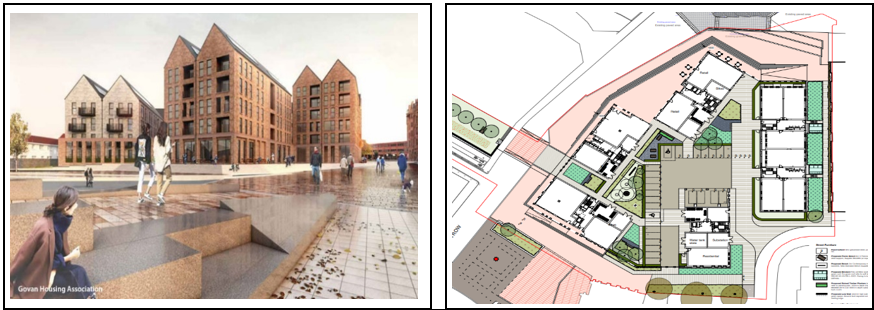
Development Details
Glasgow City Council have received a planning application for the erection of a mixed residential and commercial development (Class 1, 2, 3, 4, 7, 8, 10 and 11) with associated access, parking, open space, and public realm works.
If EV infrastructure was considered as part of the site a number of 7kw totem chargers would be installed.
- No of dwellings - 92
- No of Car parking spaces - 25
- Development Cost - £26.5m*
- Status - At Planning Stage
* The overall plan, approved in January 2019 was for £57m which includes 200 homes and 3500sqm of commercial space. For the purpose of this case study the Govan development is assumed to comprise half of the total development cost.
Where possible, we have spoken to the local authority regarding this case study, though these are purely hypothetical and should not be used as actual proposed plans.
Scottish Government preferred options
All dwellings with a parking space to have at least one EV charge point socket with minimum 7kW output power rating.
Exemption to requirement to install EV charge point if additional cost of electricity grid connection exceeds £2000.
If exemption applies ducting infrastructure to be installed in each car parking space.
Estimated EV Infrastructure Installation Costs
| Category | Average cost |
|---|---|
| Materials | £1,330 |
| Installation | £275 |
| DNO | £0 |
| Total | £1,605 |
| Category | Estimated Cost |
|---|---|
| Materials | £17,290 |
| Installation | £3,575 |
| DNO | £0 |
| Total | £20,865 |
| Category | Estimated Cost |
|---|---|
| Materials | £6,500 |
| Installation | £19,500 |
| DNO | £0 |
| Total | £26,000 |
*This is to install the chargers in situ only and does not include ducting.
All Figures above are estimates based on the example development and are potential costs derived from the bottom-up approach of market analysis. We assume 13x 7kw totem chargers with 2 sockets each (at least 1 per parking space). Figures exclude planning, traffic management and maintenance of infrastructure. DNO costs are excluded as we assume there would be network capacity as part of the new development. Average ducting costs have been estimated but may vary based on the development size. It is assumed that all parking is residential. The total cost of the development where 13 chargers are installed would be a combination of ‘By Development (13 chargers)’ and ‘By Development – Ducting Only’.
Would Exemption Apply: No, as there are no expected additional DNO costs to connect to the grid.
Regional Variations based on Geography if this development was built in different locations
Note that this development would be classed as an urban development.
| Geography | Urban | Rural | Remote Island |
|---|---|---|---|
| Total Installation Costs by charger | £579 - £1,035 | £570 - £1,030 | £777 - £1,307 |
| Total Installation Costs by development (13-chargers) | £7,527 - £13,455 | £7,420 - £13,390 | £10,101 - £16,991 |
| Exemption? | No - no expected additional DNO costs to connect to the grid. | No - no expected additional DNO costs to connect to the grid. | No - no expected additional DNO costs to connect to the grid. |
The regional variation figures above are derived from a top-down approach of data processing provided by the Energy Savings Trust (EST). Although the EST data was available for existing residential buildings, for comparison purpose, it was caveated to use for new residential buildings. EST data does not include ‘Ducting only’ as an option. EST data ranges are different from the data used in the ‘bottom-up’ approach and as such the estimated cost will not always fall within the EST data range.
Hypothetical Case Study 2: Residential Buildings Undergoing Major Renovation
Real World Planned Development: 107 Niddrie Road, Glasgow
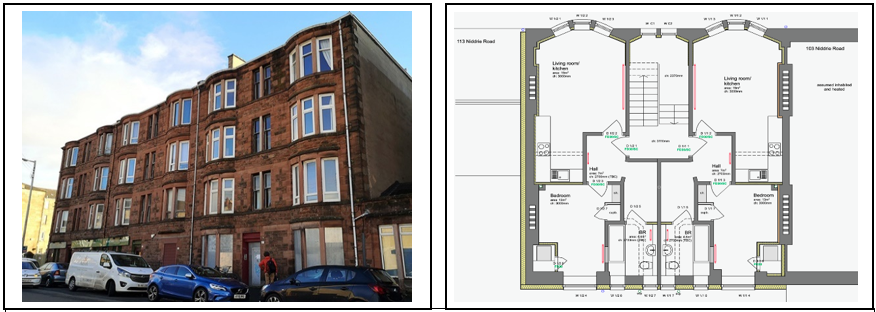
Development Details
The Niddrie Road project received funding from the Scottish Government as part of its Climate Emergency Collaboration Challenge to renovate a tenement building, The four storey 8 flat building, owned by Southside Housing Association, was empty and in a poor state of repair. A ‘hypothetical car park’ with 4 parking spaces is assumed to be included within the development as part of the refurbishment.
- No of dwellings - 8
- No of Car parking spaces - 4
- Development Cost - £704k
- Status - Completed
Where possible, we have spoken to the local authority regarding this case study, though these are purely hypothetical and should not be used as actual proposed plans.
Scottish Government preferred options
For buildings with more than 10 car parking spaces, ducting to be installed in each residential car parking space to support the future installation of an EV charge point.
EV charge points sockets to be installed, with minimum 7kW output power rating, in as many residential car parking spaces as the electrical capacity of the building post-renovation allows. Exemption applies if the cost of installing recharging and ducting infrastructure exceed 7% of total major renovation cost.
Estimated EV Infrastructure Installation Costs
| Category | Average cost |
|---|---|
| Materials | £2,888 |
| Installation | £750 |
| DNO | £2,500 |
| Total | £6,138 |
| Category | Estimated Cost |
|---|---|
| Materials | £5,776 |
| Installation | £1,500 |
| DNO | £5,000 |
| Total | £12,276 |
| Category | Estimated Cost |
|---|---|
| Materials | £1,000 |
| Installation | £3,000 |
| DNO | £1,650 |
| Total | £5,650 |
*This is to install the chargers in situ only and does not include ducting.
All Figures above are estimates based on the example development and are potential costs derived from the bottom-up approach of market analysis. We assume 2 7kw on-street chargers (total of 4 sockets) are required based on 1 socket per parking space. Figures exclude planning, traffic management and maintenance of infrastructure. DNO costs are based on interviews with charging infrastructure companies and available public information. The figure above is the average figure and quotes from the DNO will differ to this. For ducting only a hypothetical DNO cost has been included to cover negotiations relating to where to connect the ducting to. The total cost of the development where 2 chargers are installed would be a combination of ‘By Development (2 chargers)’ and ‘By Development – Ducting Only’.
Would Exemption Apply: No, as the cost to install recharging and ducting would not exceed 7% of the development cost.
Regional Variations based on Geography if this development was built in different locations
Note that this development would be classed as an urban development.
| Geography | Urban | Rural | Remote Island |
|---|---|---|---|
| Total Installation Costs by charger | £579 - £1,035 | £570 - £1,030 | £777 - £1,307 |
| Total Installation Costs by development (2 chargers) | £1,158 - £2,070 | £1,140 - £2,060 | £1,554 - £2,614 |
| Exemption? | No, as the cost to install recharging and ducting would not exceed 7% of the development cost | No, as the cost to install recharging and ducting would not exceed 7% of the development cost | No, as the cost to install recharging and ducting would not exceed 7% of the development cost |
The regional variation figures above are derived from a top-down approach of data processing provided by the Energy Savings Trust (EST). EST data does not include ‘Ducting only’ as an option.
Hypothetical Case Study 3: New Non-Residential Buildings
Real World Planned Development: Plot 3 and 4, Lammermoor Avenue, Abbotsford Business Park, Falkirk
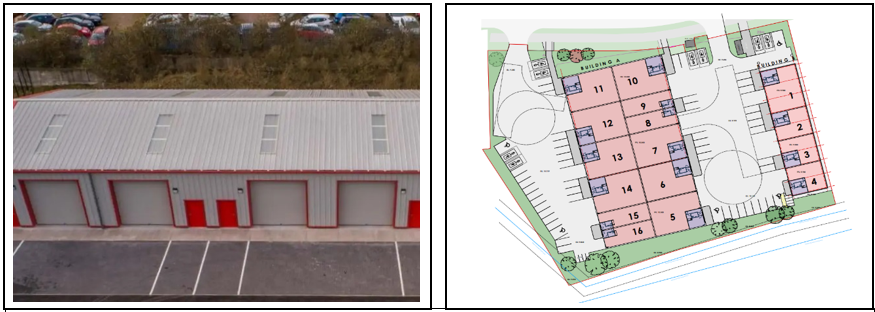
Development Details
The proposed development is for the creation of 16 commercial units on plot 3 and 4 of the Abbotsford Business Park in Falkirk. The planned development already includes provision for 4 7kw charging totems, each with 2 sockets, cabling ducts and connections to the DNO. For the purpose of this case study, it was assumed that no EV chargers are available at the moment.
- No of commercial units - 16
- No of Car parking spaces - 63
- Development Cost - £5.2m*
- Status - At Planning Stage
* Based on development figures for the original business park, built in 2016 which was for 4 units (£1.3m. £325k per unit). This base figure has been adapted based on the number of planned units.
Where possible, we have spoken to the local authority regarding this case study, though these are purely hypothetical and should not be used as actual proposed plans.
Scottish Government preferred options
For buildings with more than 10 non-residential car parking spaces, 1 in every 2 non-residential parking spaces to have ducting installed and 1 in every 10 non-residential parking spaces to provide an EV charge point socket with minimum 7kW output power rating.
Estimated EV Infrastructure Installation Costs
| Category | Average cost |
|---|---|
| Materials | £2,888 |
| Installation | £750 |
| DNO | £0 |
| Total | £3,638 |
| Category | Estimated Cost |
|---|---|
| Materials | £11,552 |
| Installation | £3,000 |
| DNO | £0 |
| Total | £14,552 |
| Category | Estimated Cost |
|---|---|
| Materials | £2,000 |
| Installation | £6,000 |
| DNO | £0 |
| Total | £8,000 |
*This is to install the chargers in situ only and does not include ducting.
All Figures above are estimates based on the example development and are potential costs derived from the bottom-up approach of market analysis. Based on the Scottish Government’s preferred option we assume 4 7kw charging totems, each with two sockets. The planned development already meets this requirement though additional ducting would be required based on the site diagrams to align with the preferred option. A combination of ‘By development – 4 chargers’ and ‘By Development – Ducting only’ would be required to ascertain the full cost. Figures exclude planning, traffic management and maintenance of infrastructure. DNO costs are excluded as we assume there would be network capacity as part of the new development. Average ducting costs have been estimated but may vary based on the development size. The total cost of the development where 4 chargers are installed would be a combination of ‘By Development (4 chargers)’ and ‘By Development – Ducting Only’.
Would Exemption Apply: No, there is no criteria relating to exemption.
Regional Variations based on Geography if this development was built in different locations
Note that this development would be classed as an urban development.
| Geography | Urban | Rural | Remote Island |
|---|---|---|---|
| Total Installation Costs by charger | £2,044 - £11,569 | £1,273 - £7,255 | £1,653 - £26,584 |
| Total Installation Costs by development (4 chargers) | £8,176 - £46,276 | £5,092 - £29,020 | £6,612 - £106,336 |
| Exemption? | No, there is no criteria relating to exemption | No, there is no criteria relating to exemption | No, there is no criteria relating to exemption |
The regional variation figures above are derived from a top-down approach of data processing provided by the Energy Savings Trust (EST). Although the EST data was available for existing non-residential buildings, for comparison purpose, it has been adapted to use for new non-residential buildings. EST data does not include ‘Ducting only’ as an option.
Hypothetical Case Study 4: Non-Residential Buildings Undergoing Major Renovation
Real World Development: Residential Care Home, Dingwall
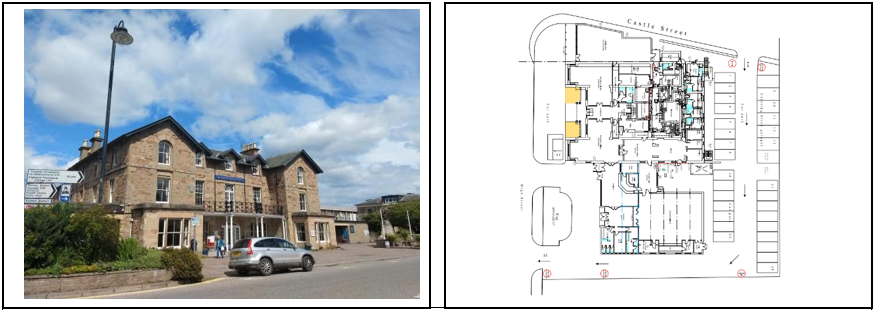
Development Details
Change of use from Hotel to Residential Institution (Residential Care) with some internal renovations including the installation of a lift
- No of commercial units - 1
- No of Car parking spaces - 45*
- Development Cost - £400k**
- Status - Complete
* Estimated based on available information
** Based on a high-level estimation of the development
Where possible, we have spoken to the local authority regarding this case study, though these are purely hypothetical and should not be used as actual proposed plans.
Scottish Government preferred options
For buildings with more than 10 non-residential car parking spaces, 1 in every 2 non-residential parking spaces to have ducting installed and 1 in every 10 non-residential parking spaces to provide an EV charge point socket with minimum 7kW output power rating.
Exemption applies if the cost of installing recharging and ducting infrastructure exceeds 7% of total major renovation cost.
Estimated EV Infrastructure Installation Costs
| Category | Average cost |
|---|---|
| Materials | £2,888 |
| Installation | £750 |
| DNO | £2,500 |
| Total | £6,138 |
| Category | Estimated Cost |
|---|---|
| Materials | £14,440 |
| Installation | £3,750 |
| DNO | £12,500 |
| Total | £30,690 |
| Category | Estimated Cost |
|---|---|
| Materials | £2,500 |
| Installation | £7,500 |
| DNO | £1,650 |
| Total | £11,650 |
* This is to install the chargers in situ only and does not include ducting.
All Figures above are estimates based on the example development and are derived from the bottom-up approach of market analysis. Based on the Scottish Government’s preferred option we assume 5 7kw charging totems, each with two sockets. Figures exclude planning, traffic management and maintenance of infrastructure. Average ducting costs have been estimated but may vary based on the development size. DNO costs are based on interviews with charging infrastructure companies and available public information. The figure above is the average figure and quotes from the DNO will differ to this. For ducting only, a hypothetical DNO cost has been included to cover negotiations relating to where to connect the ducting to. The total cost of the development where 5 chargers are installed would be a combination of ‘By Development (5 chargers)’ and ‘By Development – Ducting Only’.
To align with the Scottish Government’s preferred options, it is likely that the total cost would be a blend of ‘By Development – 5 Chargers’ and ‘By Development – Ducting Only’
Would Exemption Apply: No, as the cost of installing recharging and ducting infrastructure does not exceed 7% of the budget.
Regional Variations based on Geography if this development was built in different locations
Note that this development would be classed as a urban development.
| Geography | Urban | Rural | Remote Island |
|---|---|---|---|
| Total Installation Costs by charger | £2,044 - £11,569 | £1,273 - £7,255 | £1,653 - £26,584 |
| Total Installation Costs by development (5 chargers) | £10,220 - £57,845 | £6,365 - £36,275 | £8,265 - £132,920 |
| Exemption? | No, as the cost of installing recharging and ducting infrastructure does not exceed 7% of the budget | No, as the cost of installing recharging and ducting infrastructure does not exceed 7% of the budget | No, as the cost of installing recharging and ducting infrastructure does not exceed 7% of the budget |
The regional variation figures above are derived from a top-down approach of data processing provided by the Energy Savings Trust (EST). EST data does not include ‘Ducting only’ as an option.
Hypothetical Case Study 5: Existing Non-Residential Buildings
Real World Development: Morrisons, Peterhead
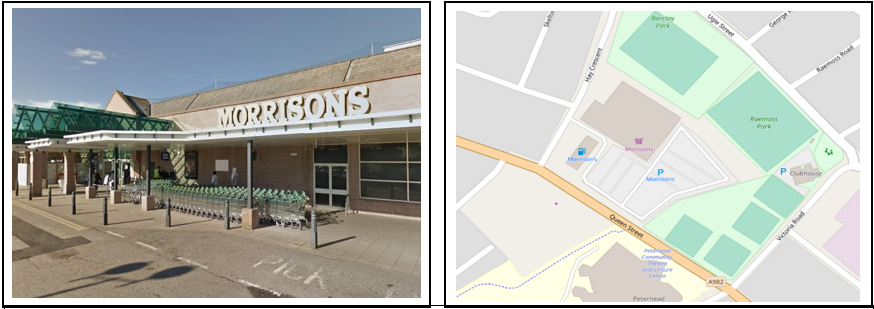
Development Details
Supermarket site with no current EV charging infrastructure.
- No of commercial units - 1
- No of Car parking spaces - 380
- Development Cost - N/A
- Status - Active site
Where possible, we have spoken to the local authority regarding this case study, though these are purely hypothetical and should not be used as actual proposed plans.
Scottish Government preferred options
By 1 January 2025, for buildings with more than 20 non-residential car parking spaces, 1 in every 2 non-residential parking space to have ducting installed and 1 in every 10 non-residential parking space to provide an EV charge point socket with minimum 7kW output power rating.
Estimated EV Infrastructure Installation Costs
| Category | Average cost |
|---|---|
| Materials | £2,888 |
| Installation | £750 |
| DNO | £2,500 |
| Total | £6,138 |
| Category | Estimated Cost |
|---|---|
| Materials | £109,744 |
| Installation | £28,500 |
| DNO | £95,000 |
| Total | £233,244 |
| Category | Estimated Cost |
|---|---|
| Materials | £19,000 |
| Installation | £57,000 |
| DNO | £1,650 |
| Total | £77,650 |
* This is to install the chargers in situ only and does not include ducting.
All Figures above are estimates and are potential costs derived from the bottom-up approach of market analysis. Based on the Scottish Government’s preferred option we assume 38 7kw charging totems, each with one socket. Figures exclude planning, traffic management and maintenance of infrastructure. DNO costs by development are based on guidance from SP Energy Networks. Developments with connections greater than 1 MVA can cost over £100k but we have simplified the cost based on a per charger cost. This development would require a maximum power capacity of 2.66 MVA so it is likely the quoted DNO cost will be higher. DNO costs are based on interviews with charging infrastructure companies and available public information, DNO costs for this stay the same as this is to cover determining where the ducting connects to. To align with the Scottish Government’s preferred options it is likely that the total cost would be a combination of ‘By Development – 38 Chargers’ and ‘By Development – Ducting Only’.
Would Exemption Apply: No, as no exemptions have been stated for this building type.
Regional Variations based on Geography if this development was built in different locations
Note that this development would be classed as an urban development.
| Geography | Urban | Rural | Remote Island |
|---|---|---|---|
| Total Installation Costs by charger | £2,044 - £11,569 | £1,273 - £7,255 | £1,653 - £26,584 |
| Total Installation Costs by development (38 chargers) | £77,672 - £439,622 | £48,374 - £275,690 | £62,814 - £1,010,192 |
| Exemption? | No, as no exemptions have been stated for this building type. | No, as no exemptions have been stated for this building type. | No, as no exemptions have been stated for this building type. |
The regional variation figures above are derived from a top-down approach of data processing provided by the Energy Savings Trust (EST).
Hypothetical Case Study 6: New Residential Building
Real World Development: King Harald Street, Lerwick
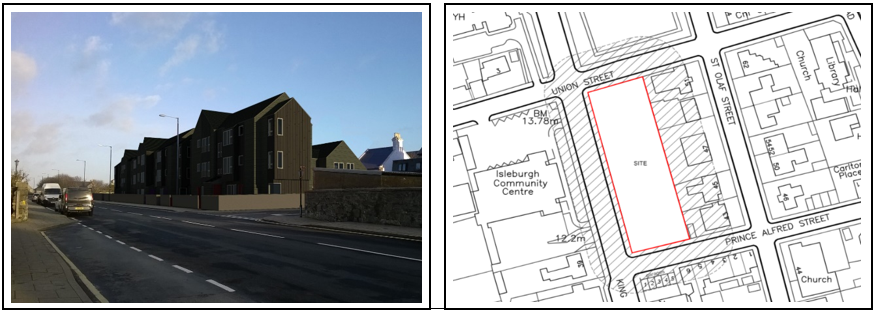
Development Details
Existing buildings demolished and replaced with three new two-three storey buildings containing in 27 one-bedroom flats. Note that the original plans did not include car parking so this hypothetical case study assumes each flat would have an associated car park and that this would be included in the development cost below.
- No of dwellings - 27
- No of Car parking spaces - 27
- Development Cost - £5.6m*
- Status - Completed site
According to Hjatland Housing Association the total investment for this development and another development of 24 dwellings in Tingwall was £10.4million. An average per dwelling cost was developed across both developments and then multiplied by the number of dwellings at this site (£204k x 27).
Where possible, we have spoken to the local authority regarding this case study, though these are purely hypothetical and should not be used as actual proposed plans.
Scottish Government preferred options
All dwellings with a parking space to have at least one EV charge point socket with minimum 7kW output power rating.
Exemption to requirement to install EV charge point if additional cost of electricity grid connection exceeds £2000.
If exemption applies ducting infrastructure to be installed in each car parking space.
Estimated EV Infrastructure Installation Costs
| Category | Average cost |
|---|---|
| Materials | £1,330 |
| Installation | £275 |
| DNO | £0 |
| Total | £1,605 |
| Category | Estimated Cost |
|---|---|
| Materials | £18,620 |
| Installation | £3,850 |
| DNO | £0 |
| Total | £22,470 |
| Category | Estimated Cost |
|---|---|
| Materials | £7,000 |
| Installation | £21,000 |
| DNO | N/A |
| Total | £28,000 |
* This is to install the chargers in situ only and does not include ducting.
All Figures above are estimates based on the example development and are potential costs derived from the bottom-up approach of market analysis. We assume 14x 7kw totem chargers with 2 sockets each (at least 1 per parking space). Figures exclude planning, traffic management and maintenance of infrastructure. DNO costs are excluded as we assume there would be network capacity as part of the new development. Average ducting costs have been estimated but may vary based on the development size. Ducting only costs can be higher than installing the charge points if the location of the charge points is unknown and it is necessary to future proof the site. The actual cost will be a blend of ‘by development (14 chargers)’ and ‘by development – ducting only’.
Would Exemption Apply: No. While there might be a £2,000 cost exemption, it is not triggered in this case.
Regional Variations based on Geography if this development was built in different locations
Note that this development would be classed as a remote island development.
| Geography | Urban | Rural | Remote Island |
|---|---|---|---|
| Total Installation Costs by charger | £579 - £1,035 | £570 - £1,030 | £777 - £1,307 |
| Total Installation Costs by development (14 -chargers) | £8,106 - £14,490 | £7,980 - £14,420 | £10,878 - £18,298 |
| Exemption? | No - no expected additional DNO costs to connect to the grid. | No - no expected additional DNO costs to connect to the grid. | No - no expected additional DNO costs to connect to the grid. |
The regional variation figures above are derived from a top-down approach of data processing provided by the Energy Savings Trust (EST). Although the EST data was available for existing residential buildings, for comparison purpose, it was caveated to use for new residential buildings. EST data does not include ‘Ducting only’ as an option. EST data ranges are different from the data used in the ‘bottom-up’ approach and as such the estimated cost will not always fall within the EST data range.